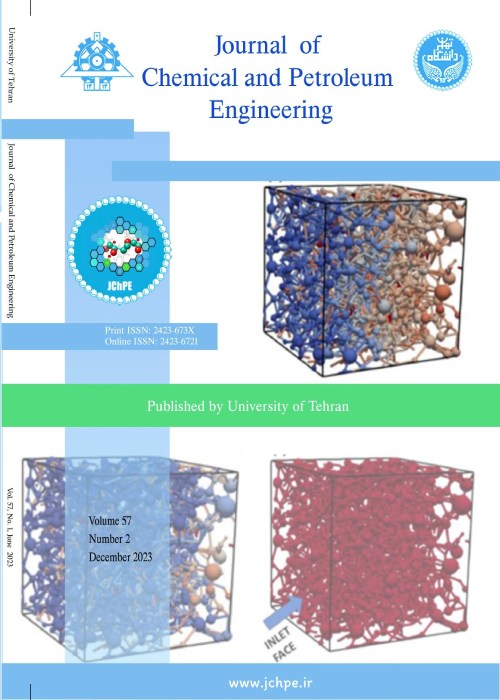فهرست مطالب

Journal of Chemical and Petroleum Engineering
Volume:50 Issue: 1, Jun 2016
- تاریخ انتشار: 1395/05/05
- تعداد عناوین: 6
-
-
Pages 1-8Water saturation (Sw) is one of the most important petro-physical parameter for evaluating the clastic horizons of hydrocarbon reservoir, which can be calculated using Archie's equation. The Archie's parameters (m, a) are the major source of uncertainty in the calculation of Sw. In order to obtain Archie's parameters, a total number of 117 sandstone samples, having resistivity measurements from Asmari Formation were studied. Due to scattered data points on the Log-Log plot of F versus Ø and to obtain reliable values for m and a parameters, the data were classified based on current zone indicator (CZI) into 6 classes of electrical flow unit (EFU). The values of parameters m and a obtained from F-Ø cross plots with excellent correlation coefficient. To avoid from data diversity and to make data applicable, the average values of m and a were obtained with considering the number of samples in each class. To assess the validation of the calculated F based on proposed values of m and a, the measured values of F versus calculated one's using Archie, Tixier and Humble formulas and proposed values were compared. The plot shows that the calculated F using Archie Tixier and Humble formulas are lower than calculated F using proposed and measured values. Applying the determined values seems to reasonably minimize the error in calculating F and therefore Sw%.Keywords: Formation factor, clastic horizons, Water saturation, core analyze, Zagros basin
-
Pages 9-13In the present research, synthesis of butyl oleate ester from oleic acid and butanol using loofa-immobilized Rhizopus oryzae as a whole cell biocatalyst (LIC) was studied in which hexane was used as the hydrophobic solvent. Decrease of mass transfer limitations as result of the interface formation between the two immiscible substrates, positively affected on the reaction progress (87% as the ester product yielded within 10 h). By applying Arrhenius equation, the activation energy of the ester synthesis was determined as Ea=18.2 kJ/mol within temperature range of 15-45°C. It was notable to test appearance of the nonlinearity in Arrhenius plot which was indicative of presence of two sections. The reaction limited region was 15-35°C; Ea=27 kJ/mol and diffusion limited region was >35°C; Ea=6.8 kJ/mol. Eventually, in this research, influence of external mass transfer on activation energy with reference to the catalytic role of the LIC in the ester synthesis was discussed.Keywords: Butyl oleate, Ester synthesis, Loofa sponge, Activation energy, Arrhenius equation
-
Pages 15-39The aim of this review is to investigate the morphological properties of polyimide based SRNF membranes by mean of image processing. Effect of phase inversion parameters like polymer concentration, volatile co-solvent, pre-evaporation time, additives in coagulation bath, polymers weight ratio in composite membranes, addition of nano particles and cross-linking agents have been reviewed. The voids of membrane were targeted to survey in the aspect of void area concentration in the SEM micrograph, mean of voids area, voids orientation and circle equivalent diameters of voids. This method by mean of the developed software could make the morphological studies of membranes easy. The population of different measured parameters of the voids could also measure. In conclusion for polyimide based membranes there are specific trends for change in voids properties by changing of phase inversion parameters. It was predictable, but investigated qualitatively up to now and this review can confirm the qualitative observations and also open new discussions about, for example void orientations that are not investigated in any study up to now.Keywords: Morphological Property, Solvent Resistant Nanofiltration, Nano, porous Membrane, Phase Inversion, Image Processing
-
Pages 41-47In consideration of physical and chemical properties of pure substances, speed of sound is one of important quantity which can used to calculate many of other thermo-physical properties such as isothermal compressibility, Joule-Thomson coefficient, isobaric heat capacity and etc. These thermo-physical properties are the main parameters in industrial and chemical processes. Development of accurate models for thermodynamic properties computation such as speed of sound is well expected above all in those fields where very high performance calculations have to be reached. In this present work, a new generalized model as a function of reduced temperature and reduced density is proposed to correlate speed of sound of methane, ethane, propane and butane halogenated refrigerants. Speed of sounds have been calculated and compared with data reported in literatures for 5600 data points of 28 refrigerants, and the overall average absolute percentage deviation of 0.92%. The source of speed of sound data used in this study is the NIST Chemistry WebBook.Keywords: Speed of sound, refrigerant, correlative model, halogenated refrigerants
-
Pages 49-67In this paper, a new robust approach based on Least Square Support Vector Machine (LSSVM) as a proxy model is used for an automatic fractured reservoir history matching. The proxy model is made to model the history match objective function (mismatch values) based on the history data of the field. This model is then used to minimize the objective function through Particle Swarm Optimization (PSO) and Imperialist Competitive Algorithm (ICA). This procedure leads to matching of history of the field in which a set of reservoir parameters is used. The final sets of parameters are then applied for the full simulation model to validate the technique. The obtained results showed that due to high speed and need for little data sets, LSSVM is the best tool to build a proxy model. Also the comparison of PSO and ICA showed that PSO is less time-consuming and more effective.Keywords: Automatic fractured reservoir history matching, ICA, LSSVM, Proxy model, PSO
-
Pages 69-78The main challenge facing the oil industry is to reduce development costs while accelerating recovery with maximizing reserves. One of the key enabling technologies in this area is intelligent well completions. Intelligent well technology (IWT) is a relatively new technology that has been adopted by many operators in recent years to improve oil and gas recovery. Intelligent well completions employ Annular Flow Control Valves (AFCVs) to balance the production profile along the length of the well completion by splitting it into two (or more) sections. The aim of intelligent wells is to optimize the production (Delaying the gas and water breakthrough and decreasing water production).
The energy that moves crude oil and natural gas from the subsurface rock to the production well is called the reservoir drive [1]. These energies because of their different mechanisms, have different effects on reservoir production. In spite of advancement in Intelligent Well Technology, the effect of intelligent well on reservoir drive mechanisms under different reservoir characterization have not been well addressed. In this paper, six conceptual models of oil reservoir have been built and different production scenarios have been discussed. Based on the objective function, scenarios will be selected and will compare with a conventional scenario and decide whether to use smart well in these models or not.Keywords: Annular flow control valves, Drive mechanisms, Intelligent Well Technology


